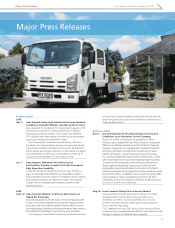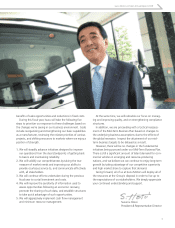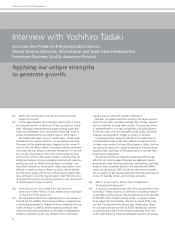Isuzu 2009 Annual Report Download - page 14
Download and view the complete annual report
Please find page 14 of the 2009 Isuzu annual report below. You can navigate through the pages in the report by either clicking on the pages listed below, or by using the keyword search tool below to find specific information within the annual report.
12
Environmental & Social Responsibilities
For the future of humanity and the Earth
Isuzu’s environmental management
Creating new opportunities
by fulfi lling our responsibilities.
Isuzu Group companies worldwide are working to prevent global warming. In addition
to developing vehicles and diesel engines with exceptional fuel economy and
environmental performance, Isuzu is committed to the goal of sustainable development.
Going forward, we will strive to reduce the environmental impact across the entire
vehicle lifecycle, from materials procurement to production, distribution, disposal, and
recycling.
Consolidated environmental management initiatives
In addition to working to increase environmental awareness
in business activities across the board, for example by adopting
the Isuzu Charter on the Global Environment in 1992, Isuzu has
implemented an environmental management system (ISO 14001)
with the goal of progressively reducing the environmental impact
of its products and strengthening its approach to environmental
management.
Isuzu introduced consolidated environmental management in
2004, and all Group companies share a common commitment to
the principles of the Global Environment Charter.
Isuzu enlarged the scope of its consolidated environmental
management system during 2008 by adding seven overseas
manufacturing plants to the system. All 23 of the Group’s major
manufacturing companies are now participating in the system.
Group manufacturing companies hold regular environmental
meetings where they discuss topics such as the extent to which
targets in areas like the prevention of global warming and the re-
duction of waste volume have been reached and work to enhance
their environmental conservation efforts. Moreover, domestic
Group manufacturing companies have established a series of
proprietary Environmental Measures Guidelines with which their
operations must comply.
Isuzu has pursued environmental initiatives in conjunction with
manufacturing plants, product development divisions, material
and parts procurement divisions, and sales companies. Going for-
ward, the Company will actively pursue consolidated environmen-
tal management in its business offices. Comprehensive coverage
of Isuzu’s environmental initiatives is available in the Company’s
annual Environmental & Social Report.
Making factories more environmentally friendly
The environmental impact associated with vehicle production is
a broad one, affecting both the local communities where factories
are located and the Earth as a whole. Isuzu’s Plant Environment
Committee is spearheading an effort to address the following four
key issues in order to achieve the Company’s vision of the factory
of the future as a facility that operates in accordance with the prin-
ciple of “Think Globally, Act Locally”:
• Preventing global warming and reducing CO
2
emissions
• Establishing a recycling-based society and reducing waste
• Establishing a pollution-free society and reducing the use of
environmentally harmful substances
• Revitalizing environmental management and complying with
environmental laws and regulations
Tackling climate change at factories
In fiscal 2008, as part of a broader effort to protect the envi-
ronment Isuzu’s manufacturing division reduced CO
2
emissions by
approximately 60% or more over 1990 levels. Specific initiatives
included the use of cogeneration systems and multi-can high-
efficiency boilers as well as energy-saving patrols. The Tochigi
Plant’s energy transition project, which is scheduled to be com-
pleted in 2009, will reduce CO
2
emissions by switching from LP gas
and kerosene to natural gas (LNG). Associated reductions in CO
2
emissions are expected to reach 4,000 tons per year. In addition,
Environmental & Social Responsibilities
























